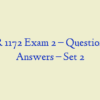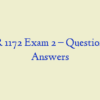Description
Pharmacology HESI Practice Exam
- The health care provider prescribes carbamazepine for a child whose tonic-clonic seizures have been poorly controlled. The nurse informs the mother that the child must have blood tests every week. The mother asks why so many blood tests are necessary. Which complication is assessed through frequent laboratory testing that the nurse should explain to this mother?
- A client is prescribed a cholinesterase inhibitor, and a family member asks the nurse how this medication works. Which pharmacophysiologic explanation should the nurse use to describe this class of drug?
- A client is ordered 22 mg of gentamicin by IM injection. The drug is available in 20 mg/2 mL. How many milliliters should be administered?
- In addition to nitrate therapy, a client is receiving nifedipine, 10 mg PO every 6 hours. The nurse should plan to observe for which common side effect of this treatment regimen?
- Which response best supports the observations that the nurse identifies in a client who is experiencing a placebo effect?
- A 42-year-old client is admitted to the emergency department after taking an overdose of amitriptyline in a suicide attempt. Which drug should the nurse plan to administer to reverse the cardiac and central nervous system effects of amitriptyline?
- A 67-year-old client is discharged from the hospital with a prescription for digoxin, 0.25 mg daily. Which instruction should the nurse include in this client’s discharge teaching plan?
- A 55-year-old client was diagnosed with schizophrenia 5 years earlier. Numerous hospitalizations have occurred since the diagnosis because of noncompliance with the prescribed medication regimen. Which drug might work best for this particular client?
- A client is being discharged with a prescription for sulfasalazine to treat ulcerative colitis. Which instruction should the nurse provide to this client prior to discharge?
- Amoxicillin, 500 mg PO every 8 hours, is prescribed for a client with an infection. The drug is available in a suspension of 125 mg/5 mL. How many milliliters should the nurse administer with each dose?
- A client with acute lymphocytic leukemia is to begin chemotherapy today. The health care provider’s prescription specifies that ondansetron is to be administered IV 30 minutes prior to the infusion of cisplatin. What is the rationale for administering Zofran prior to the chemotherapy induction?
- A client with chronic gouty arthritis is talking allopurinol, 100 mg PO daily. Which laboratory serum level should the nurse report to the health care provider to determine the therapeutic outcome?
- The nurse is reviewing prescribed medications with a female client who is preparing for discharge. The client asks the nurse why the oral dose of an opioid analgesic is higher than the IV dose that she received during hospitalization. Which response is best for the nurse to provide?
- The nurse performs a client assessment prior to the administration of a prescribed dose of dipyridamole and aspirin PO. The nurse notes that the client’s carotid bruit is louder than previously assessed. Which action should the nurse implement?
- A client experiencing dysrhythmias is given quinidine, 300 mg PO every 6 hours. The nurse plans to observe this client for which common side effect associated with the use of this medication?
- A male client with prostatic carcinoma has arrived for his scheduled dose of docetaxel chemotherapy. What symptom would indicate a need for an immediate response by the nurse prior to implementing another dose of this chemotherapeutic agent?
- The nurse is preparing to administer a secondary infusion of a dobutamine solution to a client. The nurse notes that the solution is brown in color. Which action should the nurse implement?
- Which instruction should the nurse include in the teaching plan for a client who is receiving phenytoin for seizure control?
- When providing client teaching about the administration of methylphenidate (Ritalin) to a parent of a child diagnosed with ADHD, which instruction should the nurse include in the teaching plan?
- A primigravida at 34 weeks of gestation is admitted to labor and delivery in preterm labor. She is started on a terbutaline sulfate continuous IV infusion via pump. This therapy is ineffective, and the baby is delivered vaginally. For which complication should the nurse monitor in this infant during the first few hours after delivery?
- In administering the antiinfective agent chloramphenicol IV to a client with bacterial meningitis, the nurse observes the client closely for signs of bone marrow depression. Which laboratory data would be most important for the nurse to monitor?
- A client is experiencing an adverse effect of the gastrointestinal stimulant metoclopramide HCl. Which assessment finding would require immediate intervention by the nurse?
- The nurse is scheduling a client’s antibiotic peak and trough levels with the laboratory personnel. What is the best schedule for drawing the trough level?
- A client who is HIV-positive is receiving combination therapy with the antiviral medication zidovudine. Which instruction should the nurse include in this client’s teaching plan?
- To evaluate whether the administration of an antihypertensive medication has caused a therapeutic effect, which action should the nurse implement?
- A female client with myasthenia gravis is taking a cholinesterase inhibitor and asks the nurse what can be done to remedy her fatigue and difficulty swallowing. What action should the nurse implement?
- The health care provider prescribes oral contraceptives for a client who wants to prevent pregnancy. Which information is the most important for the nurse to provide to this client?
- Dopamine is administered to a client who is hypotensive. Which finding should the nurse identify as a therapeutic response?
- A female client is receiving tamoxifen following surgery for breast cancer. She reports the onset of hot flashes to the nurse. Which intervention should the nurse implement?
- In developing a nursing care plan for a 9-month-old infant with cystic fibrosis, the nurse writes a nursing diagnosis of alteration in nutrition: less than body requirements, related to inadequate digestion of nutrients. Which intervention would best meet this child’s needs?
- The nurse is preparing to administer amphotericin B IV to a client. What laboratory data is most important for the nurse to assess before initiating an IV infusion of this medication?
- The health care provider prescribes cisplatin to be administered in 5% dextrose and 0.45% normal saline with mannitol added. Which assessment parameters would be most helpful to the nurse in evaluating the effectiveness of the therapy?
- Which question should the nurse ask a client prior to the initiation of treatment with IV infusions of gentamicin sulfate?
- A child with cystic fibrosis is receiving ticarcillin disodium for Pseudomonaspneumonia. For which adverse effect should the nurse assess and report promptly to the health care provider?
- Which statement indicates that client teaching regarding the administration of the chemotherapeutic agent daunorubicin HCl has been effective?
- A client has a positive skin test for tuberculosis. Which prophylactic drug should the nurse expect to administer to this client?
- The nurse notes that the hemoglobin level of a client receiving darbepoetin alfa has increased from 6 to 10 g/dL over the first 2 weeks of treatment. Which action should the nurse take?
- During the initial nursing assessment history, a client tells the nurse that he is taking tetracycline hydrochloride for urethritis. The nurse is most concerned if the client reports taking which medication concurrently?
- A client with metastatic cancer who has been receiving fentanyl for several weeks reports to the nurse that the medication is not effectively controlling the pain. Which intervention should the nurse initiate?
- A client being treated for an acute myocardial infarction is to receive the tissue plasminogen activator alteplase. The nurse would be correct in providing which explanation to the client regarding the purpose of this drug?
- A client with angina pectoris is instructed to take sublingual nitroglycerin tablets PRN for chest pain. Which instruction should the nurse include in the client’s teaching plan?
- The nurse is preparing a plan of care for a client receiving the glucocorticoid methylprednisolone. Which nursing diagnosis reflects a problem related to this medication that should be included in the care plan?
- The nurse is providing discharge instructions to a client who has received a prescription for an antibiotic that is hepatotoxic. Which information should the nurse include in the instructions?
- When providing nursing care for a client receiving pyridostigmine bromide for myasthenia gravis, which nursing intervention has the highest priority?
- Minocycline, 50 mg PO every 8 hours, is prescribed for an adolescent girl diagnosed with acne. The nurse discusses self-care with the client while she is taking the medication. Which teaching points should be included in the discussion? (Select all that apply.)
- Which nursing intervention has the highest priority during IV administration of mechlorethamine HCl and actinomycin?
- Methenamine mandelate is prescribe for a client with a urinary tract infection and renal calculi. Which finding indicates to the nurse that the medication is effective?
- Methylphenidate is prescribe for daily administration to a 10-year-old child with attention-deficit/hyperactivity disorder (ADHD). In preparing a teaching plan for the parents of this child newly diagnosed with ADHD, which instruction is most important for the nurse to provide to the parents?
- Following the administration of sublingual nitroglycerin, which assessment finding indicates that the medication was effective?
- A client who is receiving chlorpromazine HCl to control his psychotic behavior also has a prescription for benztropine. When teaching the client and/or significant others about these medications, what should the nurse explain about the use of benztropine in the treatment plan for this client?
- A client who arrives in the postanesthesia care unit (PACU) after surgery is not awake from general anesthesia. Which action should the nurse implement first?
- The charge nurse is reviewing the admission history and physical data for four clients newly admitted to the unit. Which client is at greatest risk for adverse reactions to medications?
- A client with viral influenza is receiving vitamin C, 1000 mg PO daily, and acetaminophen elixir, 650 mg PO every 4 hours PRN. The nurse calls the health care provider to report that the client has developed diarrhea. Which change in prescriptions should the nurse anticipate?
- The nurse is preparing to apply a surface anesthetic agent for a client. Which action should the nurse implement to reduce the risk of systemic absorption?
- A client is taking famotidine. Which client statement should the nurse further assess because it may indicate that the client is experiencing a side effect of this drug?
- The nurse knows that certain antipsychotic drugs cause extrapyramidal symptoms. Which extrapyramidal symptom is a permanent and irreversible adverse effect of long-term phenothiazine administration?
- A client who is hypertensive receives a prescription for hydrochlorothiazide. When teaching about the side effects of this drug, which symptoms are most important for the nurse to instruct the client to report?
- The nurse is reviewing a client’s laboratory results before a procedure in which a neuromuscular blocking agent is prescribe. Which finding should the nurse report to the health care provider?
- A psychiatric client is discharge from the hospital with a prescription for haloperidol. Which instruction should the nurse include in the discharge teaching plan for this client?
- A female client with trichomoniasis (Trichomonas vaginalis) receives a prescription for metronidazole. Which instruction is most important for the nurse to include in this client’s teaching plan?
- A client is receiving oral griseofulvin for a persistent tinea corporis infection. Which response by the client indicates an accurate understanding of the drug teaching conducted by the nurse?
- A female client is receiving tetracycline for acne. Which client teaching should the nurse include?
- A client receives a prescription for theophylline PO to be initiated in the morning after the dose of theophylline IV is complete. The nurse determines that a theophylline level drawn yesterday was 22 mcg/mL. Based on this information, which action should the nurse implement?
- A 3-year-old boy is admit to the emergency department after ingesting an unknown amount of phenobarbital elixir prescribed for his brother’s seizure disorder. Which nursing intervention should the nurse implement first?
- A pediatric client is discharge home with multiple prescriptions for medications. Which information should the nurse provide that is most helpful to the parents when managing the medication regimens?
- When caring for a client on digoxin therapy, the nurse knows to be alert for digoxin toxicity. Which finding would predispose this client to developing digoxin toxicity?
- The nurse is administering the early morning dose of insulin aspart, 5 units subcutaneously, to a client with diabetes mellitus type 1. The client’s fingerstick serum glucose level is 140 mg/dL. Considering the onset of insulin aspart, when should the nurse ensure that the client’s breakfast be given?
- A client taking linezolid at home for an infected foot ulcer calls the home care nurse to report the onset of watery diarrhea. Which intervention should the nurse implement?
- During therapy with isoniazid, it is most important for the nurse to monitor which laboratory value closely?
- The nurse is preparing a teaching plan for a client who has received a new prescription for levothyroxine sodium. Which instruction should be include?
- A 2-month-old infant is schedule to receive the first DPT immunization. What is the preferred injection site to administer this immunization?
- During administration of theophylline, the nurse should monitor for signs of toxicity. Which symptom would cause the nurse to suspect theophylline toxicity?
- Dopamine, 5 mcg/kg/min, is prescribe for a client who weighs 105 kg. The nurse mixes 400 mg of dopamine in 250 mL D5W for IV administration via an infusion pump. What is the hourly rate that the nurse should set on the pump?
- The nurse plans to draw blood samples for the determination of peak and trough levels of gentamicin sulfate in a client receiving IV doses of this medication. When should the nurse plan to obtain the peak level?
- A client with Tourette syndrome takes haloperidol to control tics and vocalizations. The client has become increasingly drowsy over the past 2 days and reports becoming dizzy when changing from a supine to sitting position. Which action should the nurse take?
- A client who is experiencing an acute attack of gouty arthritis is prescribe colchicine USP, 1 mg PO daily. Which information is most important for the nurse to provide the client?
- Alteration of which laboratory finding represents the achievement of a therapeutic goal for heparin administration?
- A client is receiving acyclovir sodium IV for a severe herpes simplex infection. Which intervention should the nurse implement during this drug therapy?
- A chemotherapeutic regimen with doxorubicin HCl is being plan for a client recently diagnose with cancer. What diagnostic test results should the nurse review prior to initiating this treatment?
- A client receives pancuronium, a long-acting, nondepolarizing neuromuscular blocker, during surgical anesthesia. Which client situation should alert the nurse to evaluate the client for a prolonged muscle relaxation response to this medication?
- Two hours after taking the first dose of penicillin, a client arrives at the emergency department complaining of feeling ill, exhibiting hives, having difficulty breathing, and experiencing hypotension. These findings are consistent with which client response that requires immediate action?
- male client asks the nurse why condoms should not be lubricate with the spermicide nonoxynol-9. Which response is best for the nurse to provide?
- A 4-year-old child is receiving chemotherapy for acute lymphocytic leukemia. Which laboratory result should the nurse examine to assess the child’s risk for infection?
- An older client who had a colon resection yesterday is receiving a constant dose of hydromorphone via a patient-controlled analgesia (PCA) pump. Which assessment finding is most significant and requires that the nurse intervene?
- Prior to administering a scheduled dose of digoxin, the nurse reviews the client’s current serum digoxin level, which is 1.3 ng/dL. Which action should the nurse implement?
- The nurse is preparing a child for transport to the operating room for an emergency appendectomy. The anesthesiologist prescribes atropine sulfate, IM STAT. What is the primary purpose for administering this drug to the child at this time?
- A child is being treated with mebendazole for pinworms. Which type of diet should the mother be instructed to feed the child while the child is receiving this medication?
- The nurse has completed diabetic teaching for a client who has been newly diagnosed with diabetes mellitus. Which statement by this client would indicate to the nurse that further teaching is needed?
- The apical heart rate of an infant receiving digoxin for congestive heart failure is 80 beats/min. Which intervention should the nurse implement first?
- A client is receiving antiinfective drug therapy for a postoperative infection. Which complaint should alert the nurse to the possibility that the client has contracted a superinfection?
- Which medication is useful in treating digoxin toxicity?
- A 45-year-old female client is receiving alprazolam for anxiety. Which client behavior would indicate that the drug is effective?
- A client receives an antihypertensive agent daily. Which action is most important for the nurse to implement prior to administering the medication?
- The health care provider prescribes the anticonvulsant carbamazepine for an adolescent client with a seizure disorder. The nurse should instruct the client to notify the health care provider if which condition occurs?
- The nurse is evaluating a client’s understanding of the prescribed antilipemic drug lovastatin. Which client statement indicates that further teaching is need?
- A 6-year-old child is admit to the emergency department with status epilepticus. His parents report that his seizure disorder has been manage with phenytoin, 50 mg PO bid, for the past year. Which drug should the nurse plan to administer in the emergency department?
- A client who has trouble swallowing pills intermittently has been prescribed venlafaxine (XR) for depression. The medication comes in capsule form. What should the nurse include in the discharge teaching plan for this client?
- A client is receiving pyridostigmine bromide to control the symptoms of myasthenia gravis. Which client behavior would indicate that the drug therapy is effective?
- When developing a written nursing care plan for a client receiving chemotherapy for treatment of cancer, the nurse writes, “Assess each voiding for hematuria.” The administration of which type of chemotherapeutic agent would prompt the nurse to add this intervention?
- Which factor is most important to ensure compliance when planning to teach a client about a drug regimen?
- A client with a ….shoulder is being prepare for a closed manual reduction using conscious sedation. Which medication should the nurse explain as a sedative used during the procedure?
- A client with metastatic cancer reports severe continuous pain. Which route of administration should the nurse use to provide the most effective continuous analgesia?
- A mother brings her 18-month-old child to the community health center because the child has had “bad diarrhea” for the last 3 days. She states, “I bought some of this liquid at the pharmacy and gave my daughter a half-ounce.” The nurse sees that the bottle contains loperamide. Which intervention is most important for the nurse to implement initially?
- The health care provider prescribes ipratropium for a client. An allergic reaction to which other medication would cause the nurse to question the prescription for?
- Which parameter is most important for the nurse to check prior to administering a subcutaneous injection of heparin?
- An older client is receiving a water-soluble drug that is more than the average dose for a young adult. Which action should the nurse implement first?
- A client who is HIV-positive is receiving epoetin alfa for the management of anemia secondary to zidovudine (AZT) therapy. Which laboratory finding is most important for the nurse to report to the health care provider?
- A lidocaine IV infusion at 4 mg/min via infusion pump is prescribe for a client having premature ventricular contractions (PVCs). The available premixed infusion contains 2 mg/mL of D5W. How many milliliters per hour should the nurse program the pump to deliver to this client?
- The nurse is preparing to administer the disease-modifying antirheumatic drug (DMARD) methotrexate to a client diagnosed with rheumatoid arthritis. Which intervention is most important to implement prior to administering this medication?
- Which class of antineoplastic chemotherapy agents resembles the essential elements require for DNA and RNA synthesis and inhibits enzymes necessary for cellular function and replication?
- A client with HIV who was recently diagnose with tuberculosis (TB) asks the nurse, “Why do I need to take all of these medications for TB?” What information should the nurse provide?
- Which intervention is most important for a nurse to implement prior to administering atropine PO?
- Which instructions should the nurse provide to an adolescent female client who is initiating treatment with isotretinoin for acne vulgaris? (Select all that apply.)
- A 26-year-old primigravida client is experiencing increasing discomfort and anxiety during the active phase of labor. She requests something for pain. Which analgesic should the nurse anticipate administering?
- A female client who has started long-term corticosteroid therapy tells the nurse that she is careful to take her daily dose at bedtime with a snack of crackers and milk. Which is the best response by the nurse?
- A client who has chronic back pain is on long-term pain medication management and asks the nurse why his pain relief therapy is not as effective as it was 2 months ago. How should the nurse respond?
- For which clients should the nurse withhold the initial dose of a cyclooxygenase 2 (COX-2) inhibitor until notifying the health care provider? (Select all that apply.)
- The health care provider prescribes the H2 antagonist famotidine, 20 mg PO in the morning and at bedtime. Which statement regarding the action of H2 antagonists offers the correct rationale for administering the medication at bedtime?
- The nurse is assessing a stuporous client in the emergency department who is suspect of overdosing with opioids. Which agent should the nurse prepare to administer if the client becomes comatose?
- The health care provider has prescribed a low-molecular-weight heparin, enoxaparin prefilled syringe, 30 mg/0.3 mL IV every 12 hours, for a client following hip replacement. Prior to administering the first dose, which intervention is most important for the nurse to implement?
- A 19-year-old male client who has sustained a severe head injury is …and place on …mechanical ventilation. To facilitate optimal ventilation and prevent the client from “fighting” the ventilator, the healthcare provider administers pancuronium bromide IV, with adjunctive opioid analgesia. What medication should be immediately accessible for a potential complication with this drug?
- Which physiologic mechanism explains a drug’s increase metabolism that is trigger by a disease process?
- A client receiving a continuous infusion of heparin IV starts to hemorrhage from an arterial access site. Which medication should the nurse anticipate administering to prevent further heparin-induced hemorrhaging?
- A client with mild parkinsonism is start on oral amantadine. Which statement accurately describes the action of this medication?
- Which assessment datum indicates to the nurse that a dose of granisetron administered IV prior to chemotherapy has had the desired effect?







